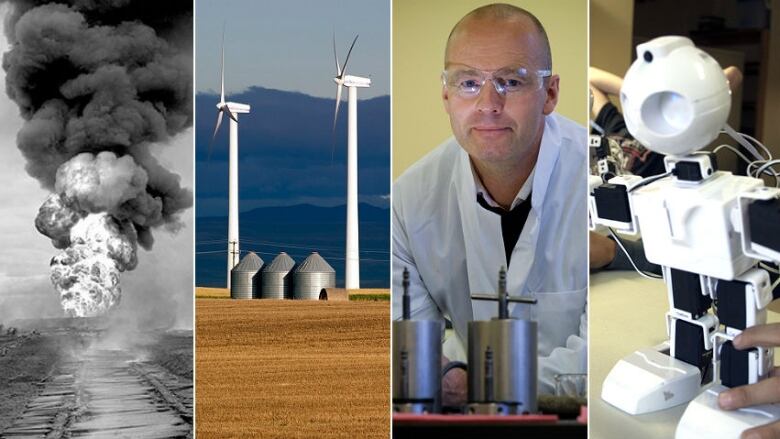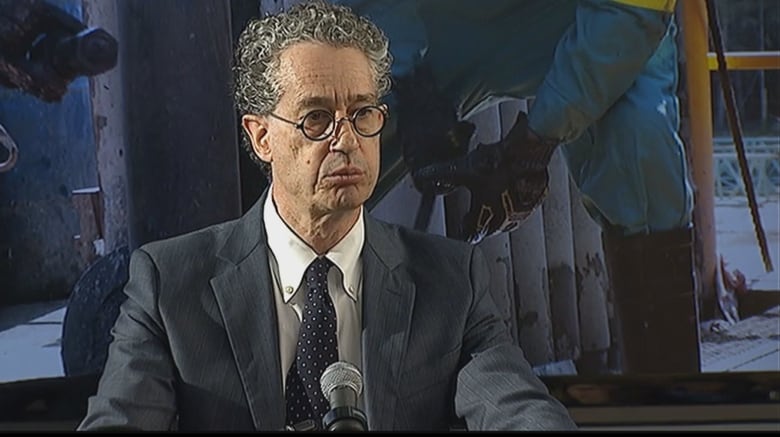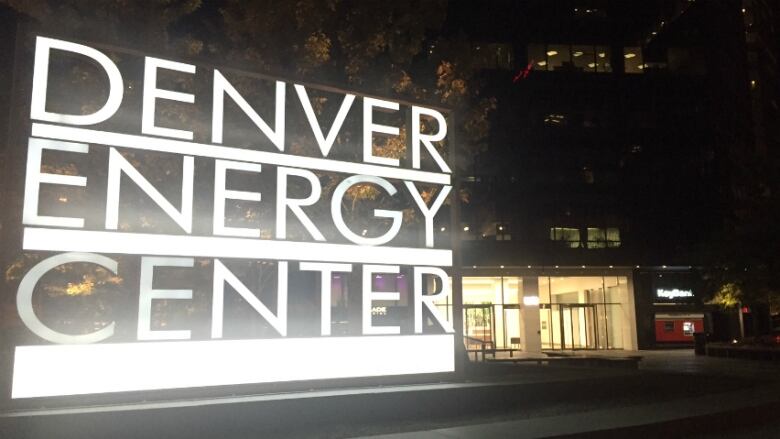The growing pains Alberta faces as it sheds its boom-and-bust past
It will be a slow transition, but it's already underway and that includes the energy industry, itself

EDITOR'S NOTE: This is the third in a five-part series that's a little different from what you usually read on CBC. In it, we add new reporting and analysis to the work of dozens of writers who have contributed to ourCalgary at a CrossroadsandRoad Aheadprojects over the past three years.The goal is to take stock of the turbulent times we've been through while exploring where we're headed next and how we might get there.
The series was initially published in February. We're resurfacing it in March for those who may have missed it.
Alberta won the geological lottery back in 1947 with Leduc's famous gusher,and we've been a place of boom and bust ever since.
Here in Calgary, in particular, we have come to accept that economic roller-coaster. But this time, somehow, the wild ride feels different.
And it's not just the sense you get from people swapping anecdotes in coffee shops and bars. It's different decisionsbeing made by individuals, institutions, government and industry. Those involved in the energy business, especially, are making changes based on the expectation of new realities.
They're planning for a future that doesn't look like the past.
We'vespent the last few years decades,actually talking about the need to diversify the economy. We've long recognized the need to build on the energy industrythat we have, while putting eggs into other baskets, too. Oft-mentioned options include transportation, agriculture andhigh tech.
If this latest iteration of the bust-downturn-recession-recovery patternis indeeddifferent, then perhaps Alberta has an opportunity to retool and transform the way we think of the economy and even work, itself.
But to do this, weface a lot of choices.
A new reality
Let's begin with Alberta's bedrock: the energy industry.
During the downturn, billion-dollar decisions were still being made. Radical employment shiftsoccurred. Companies adjusted to anew government. Technological advances combined with economic and social forces from around the world to drive further change.
"I call them the biggest changes in 100 years," said economist Peter Tertzakian, executive director of the ARCEnergy Research Institute. (We'll visit some of those later.)
Added to the mix of international geopolitics is the distinctly Canadian phenomenon of interprovincial politics. (Read: pipeline disputes.)
"And finally," Tertzakian said, "the big pressure every industry feels is technology."
It's a shared view.

"We have hit a new era," said AdamLegge, director of the Global Business Futures Initiative at the University of Calgary'sHaskayneSchool of Business.
"Theworld is having very different conversationsaboutwhere it wants its energy."
While Alberta's energy companies have already gone through a painful process of becoming leaner andmore efficient, many are looking beyond the present and toward the uncharted future of their business.
Some would say they have little other choice.
'Anew era for the energy industry'
The transition from oil and gas to renewable poweris already well underway and likely to reach a tipping point in less than two decades, according to a reportproducedlast fall by energy consultancy Wood Mackenzie.
"The next phase, to the age of power and renewables, has already begun," the report reads.
It predicts nearly 20 per cent of global power needs will be met by solar or wind by 2035. Meanwhile, upwards of 20 per cent of all distances travelled globally by vehicles from buses to bikes will use electric motors. Further, the firmestimates oil demand will peak by 2036.

"We expect the energy industry to reach its point of singularity by 2035, when the critical disruptive trends that are driving change converge," the report adds.
"This is the point of no return, and represents a new era for the energy industry."
Such predictions, of course, should be understood as just that, predictions. They're an educated forecast of the future from a particular organization. For its part, the Canadian Association of Petroleum Producers expects global demand for oil and natural gas to continueto increase for decades to come.
But there's no question that significant conversations are being had in the head offices of energy companies around the world. Conversations about difficult choices.
So, what does the future of energy look like?
Calgary, energy city
Few people in Alberta would recommend throwing the baby out with the bath water.
Many in the industrybelieveoil and gas will have a long tail no matter how, or when, an energy transition occurs. The petrochemical sector which produces the kind of plastics used in everyday goods from chairs to rugs to medical equipment is also part of the picture. The same can be said for liquefied natural gas.
The renewable energy industry, meanwhile, still has its own technological and infrastructure challenges to figure out, like energy storage, though it seems to havea gathering momentum.
Legge says Calgary will continue to be an energy city going forward, and many economists agree. However, Leggesuggestswe should also broaden our definition of energy. We have an opportunity, he says, to build on the city's traditional strengths in oil and gas and apply themto other elements of energy as well.
"We have to adapt," addsTertzakian, the energy economist.
"And as we adapt, there will be new skills that will be needed. And it is the new skills and the next generation of oil and gas worker, which will be much more technical, that will fill those towers, as well as other industries."

Faced with hard choices in these last few years, the industry has already made changes.
Consider the advances in shale drilling, for example.
Not so long ago, it could take more than two dozen rig workers operating diesel pumps and using headsets to synchronize the throttle and pressure needed to break apart rock formations and free the trapped crude. Today, it might take two peoplesitting inside a control van, monitoring automated systems.
This is a consequence of innovation. Fewer people are needed to do the same work. So even if Alberta's boom returned, some of the old jobs may not. Simply put, oil producers can now unlock more oil and natural gas from the ground than ever before,and they don't need to drill nearly as many wells to do it.
Industry has learned to do more with less through innovation and new technology.It'salso branching outin new directions.
Shell Canada, for example, is running a project that aims to extract vanadium (a metal) from oilsands bitumenand use it to make large, utility-scale electricity storage (batteries) for the renewable energy sector.

Canadian Natural Resources, meanwhile,has been working on an oilsandsextraction process that would eliminate the need for tailings ponds and reduce greenhouse gas emissions. And both ATCO and Enbridge are spearheading separate projects aimed at using hydrogen to store electricity.
This comes as energy companies worldwide invest large sums in renewable energy. Morgan Bazilian, former lead energy specialist at the World Bank, told a Calgary audience last spring the industry has already seen some of its largest companies Shell, Total, BP and others make billion-dollar investments in renewables.
Alberta itself has also becomea hotbed of wind and solaractivity within Canada.
All this said, the province remains rooted in oil and gas.
A critical time
Oilsands and conventional drilling still represents 30 per cent of all economic activity in the province, according to the Canadian Association of Petroleum Producers, "when direct, indirect, and induced factors are taken into consideration."
And the industry is strivingto see investment climb. By 2020, CAPPhopes growth in Alberta will helpCanada become the fourth-largest oil producer in the world, passing Iraq and China.
"It's a critical time to define a long-term vision for the oil and natural gas industry, and begin to make key decisions to position industry for success in addressing challenges to pursue this opportunity," CAPP said in January.
The hope, economically speaking, is that this isn't an either/or discussion, but rather that Alberta's energy sector can evolve and thrive while other industries strengthen and grow.
But hope alone won't get us where we need to go.
Tertzakian believes Alberta's energy leaders the top executives of major oil and gas companies ought to do more to help Canadiansunderstand the challenges the industry is facing and what that means on a national level.
"The message is not getting out to the rest of the country," hesaid. "So when I am confronted by the anger and frustration and the 'nobody's listening to us,' I say, 'Well, what have you done? Have you been to Burnaby? Have you been to Ottawa? Have you been to Toronto? Have you talked to people?'"
So what are those messages that theindustry wants (but in Tertzakian's view, has often failed) to get out?
The importance of energy revenue to the national economy. The need for pipelines. The changes industry has made to control emissions. The potential of renewable resources. The possibility of diversity within the industry.
The challenge is that these messages can be complex, and they don't resonate with everyone. One key factor is themounting urgency and concernsurroundingthe state of climate change around the world.Indeed, more Canadians seeglobal climate changeas a greater threat to their countrythan cyber-attacks, ISISor the state of the world economy, according to a Pew Research survey conducted last year.
"Global pressure to decarbonise is growing," The Economist warned in a December article that focused on Alberta.
The impact of the fossil fuel industry and the oilsands in particular is under increasing scrutiny from politicians, the courts, scientists and environmentalists. So when CAPP says it wants to ensurethe rate of growth in Alberta's oil and natural gas supply doubles to help meet global demand, Greenpeace raises an alarm.
"Oil and gas is the major obstacle to Canada actually being a climate leader and not just talking about being a climate leader," Dale Marshall, national program manager for Environmental Defence, said during United Nations climate talks in December.

So we have a multiplicity of messages, each with its own advocates. This gets back to something we've mentioned before in this series.
Agency.
The ability to actually make meaningful change or have an impact.
And perhaps one of the most critical areas in which we can effect change is in building a more resilient and diverse economy.
The diversification dilemma
"The future is going to be very different from the past and not everybody's there," said Jim Gray, who spent 45 years in the oilpatch and is a member of the Canadian Petroleum Hall of Fame.
"We've got a very narrow base, which means that it's highly dependent on oil prices, oil supply and demand, and therefore it's been highly, highly volatile. That has to change. We have to broaden the base of this city."
You can take such a call seriously when it comes from one of the grand old men of oil and gas.

And "broaden the base" is another way of saying "diversification".
Yes, diversification. It's been the watchword here in Calgary since the downturn began.
An ATB Financial report released last week helps explain why having our eggs in more than one basket is beneficial. Even the limited degree to which Alberta has diversified its economy from that of a decade or two ago has helped build resilience.
"Despite concern around pipelines and other global pressures, Alberta continues to hold its own among the provinces," the report reads. "Retail activity, manufacturing, wholesale trade and other economic indicators are hovering around pre-recession levels while sectors including agriculture, tourism and the tech sector have seen growth."
So. There's money there.
But without a well explained and shared strategy, any talk of "diversification" is simply rhetoric. It's also somewhere Calgary has been before and with similar urgency.
"Our economy is overly dependent upon mature resource-based industries [and] we have yet to establish new economic drivers," warned one civic study, which pointed to growing environmental concern with fossil fuels as just one reason to diversify.
The report was big news not in 2018, but in 1989, which illustrates two things. First, leaders have long known about the dangers of the city's one-legged economic structure. Second, the lucrative upside of the energy business made it easy for many people to put off the hard work for too long.
This may also be behind our own version of a faint-hope clause in Alberta: If oil prices would just rise, we'dbe rich again.
By contrast, let's look to Colorado.

The City of Denver once faced the same kind of decision. Similar to Calgary in size andreliance on oil and gas, it suffered through a recession in the 1980s. But where Calgarians waited it out, people in Denver went another way.
"They decided they were going to start again,"said Tom Clark with the Metro Denver Economic Development Corporation. "And this time, as they had said in the1970s, 'We mean it this time. We really are going to diversify our economy.'"
Numerous, complementary steps were taken. The city and its neighbouring counties made an agreement to stop competing for new business and employees. Economic development funds were set up. Specific neighbourhoods were built to accommodate specific industries. New deals were cut on regional tax rates. Plans were enacted to recruit key businesses.
It worked, in large part,for Denver.
So, can Calgary get there?
Selling a diverse Calgary
Diversification isn't easy, especially in a globalized world.There's a lot of hard work that lies ahead.
And here's some news few will want to hear: It's going to take a long time.
"When you're facing unemployment and you're running out of savings... patience is not tonic," saidLegge, with the Haskayne School of Business. "But the reality is you cannot fill the hole of what was impacted from oil and gas in anything probably less than a decade."
Calgary Economic Development's approach to diversification is to build off the city's core strengths like energy, agribusiness and transportation logistics as well as emerging sectors such as life sciences, health, tourism and the creative industries.
As well, CED is out selling Calgary to a wide variety of business in Silicon Valley, Seattle, Vancouver and London. It's been active in India and China as well.
The pitch?
Calgary has the headquarters, industries and opportunities to grow a business.

Take transportation, for example.
"If you want to be a game changer in transportation, come to Calgary, because Calgary is one of the only cities in North America with a headquarters of a Class 1 railway and a headquarters of an airline," saidCourt Ellingson, CED's vice-president of research and strategy.
Back to our Denver example.That city, too, did a major sales job on transportation, and backed it up by making itself a major shipping hub in the western United States, with an airport expansion and attracting major airline presence.
Richard White, one of Calgary's best-known urban writers and a former city planner, says Calgary has become the major distribution centre for Western Canada, but more could be done to maximize this potential, including following Denver's example of designing communities to woo specific industries.
Legge also believes Calgary should focus on things it already does well, because landing the "big fish" think Amazon's HQ2 rarely happens.
"So what you do is you build off your strengths and it happens organically over time," he said.
"The one that I think is low-hanging fruit and I am still surprised that it has not been pursued more aggressively is agriculture."
Stan Blade also sees opportunity here.
"This is a very exciting time for agriculture and food," the dean of agricultural, life and environmental sciences at the University of Alberta said last year.

"There really has been sort of this renaissance of people that are re-engaging and obviously they're doing it because they see there's a real economic opportunity that they are pursuing."
Agriculture and agri-food may not replace the "golden goose" of the oilpatch, but their contribution shouldn't be overlooked nor should thepotential for growth, according toRob Roach withATB Financial's economics and research team.
"That translates into billions of dollars in economic activity and that can make the difference between a good year in the province and a bad," Roach said.
But at the same time,Legge cautions against spreading ourselves too thin.
'Tough conversations'
Legge'sonly criticism of CED's current strategy is that it's "probably too broad."
In addition to its primary areas of focus energy, agriculture, transportation he said the agency is also devoting resources to those "emerging sectors" that Leggebelieves are important, too, but risk becoming a distraction.
"While it's good to put those on the table, I think if we begin to give those a lot of energy and attention, you're taking that away from the three real potentials that you have," said Legge, who was once CED'schief economist. "So in terms of getting to success in the three, I think you have to reduce the attention on all the others. And that makes it tough. Those are tough conversations."
Again, we face choices.

There are a multiplicity of strategies but what the public so often wantsis a singular plan something they can rally around.
As it stands, however,we are faced with a complex list of needs.
We need to diversify, but we need to concentrate on our core business sectors. We need to craft a broad appeal to open up economic possibilities, while narrowing down what we want to focus on as a core strength.
How we actually, practically, do this through core messages, government policy, strategic industry investments, municipal tax changes,urban planning and rewriting the brochures remains to be seen.
But let's turn to the thing that, in the modern globalized economy, is often held up as some kind of salvation.
High tech.
Calgary's complicated relationship with high-tech
Calgary has a long way to go to as a technology hub toward building an ecosystem around the high-tech industry.
But here too, there is progress.
Even just a few years ago, people with tech ambitions struggled to make a mark. Many leftto find the expertise, money or mentorship they craved. Today, the city is beginning to develop a network of expertise to help entrepreneurs take a good idea and build it into something tangible, right here at home.
"Back in the late '90s, early 2000s, there was nowhere near the support and the infrastructure that there is today," saidAlice Reimer, who co-founded (and later sold) a firm whose technology is now used by retailers like Walmart, Home Depot, and Staples.
"If you have even an inkling of interest in entrepreneurship and innovation," she said, "there is at least one event you could go to every week in order to get yourself connected."
Some of these opportunities are informal, such as meetings of like-minded entrepreneurs. Others are more systemic.

Take the work of the Creative Destruction Lab at the University of Calgary's Haskayne School of Business, where Reimer is the site lead. In the simplest terms, it tries to help science projects become high-growth companies. In its first year, it received 170 applications for the 25 spots. The startups chosen raised nearly $14 million in seed funding. Last fall, another 25 spots were added to the program, with a focus on energy.
Reimer also points to other educational investments, including the U of C's new Life Sciences Innovation Hub. Set to open in July, it will help support specialized programming for entrepreneurs and early-stage companies.
"We have to continue to invest for the long game," Reimer said.
No instant fixes, but alongprocess of small wins.
And therehavebeen some notable successes on the tech front.
Technology victories
Take Benevity, a Calgary-based software firm that helps companies better manage their charitable donations.
In 2008, the company consisted of four software developers working above a shawarma shop. Today, it's an international firm with hundreds of employees spanning two continents.
Or consider DIRTT, a modular interiors company that uses proprietary, videogame-like technology. It now has offices and factories in cities across North America and a customer list that includes both Apple and Google.
Earlier this month, Solium Capital Inc., which provides cloud-enabled services for global equity administration, was bought by U.S. bank Morgan Stanley for $1.1 billion.
And New World Interactive, a Denver-based video game developer, announced recently that they'd picked Calgary over Toronto as the home for its first Canadian studio. Attracted by potential incentives and lower costs, the firm said it hopes to employ as many as 60 people at its Inglewood office.

But even successes lead to new challenges.
One of the main reasons put forth for Calgary's failed Amazon HQ2 bid was the city's lack of pre-existing talent in the high-tech industry.
"By 2023, you're looking at a shortfall of 1,200 positions that's for programmers, database analysts, software engineers,"said AlanFedoruk, chairof mathematics and computing at Mount Royal University.
"So that's big."
And that's the shortfall we could face even before trying to bring in new business dashing a bit of cold water on our high-tech hopes.
Still, CED is on the hunt.
Broad appeal vs. specific targets
"If we attracted 100 new companies here with 50 people each, that would be significant," Ellingson said.
"It's not akin to Amazon HQ2, but it is significant. And so, the majority of our work is in working with companies that are in that ... 50-to-100-potential-jobs space."
This brings us back to the idea we raised earlier: looking for amultiplicity of smaller solutions, rather than one, big, quick fix. Incremental growth, not a silver bullet.A diversificationstrategy of nuanced policy change and minute, tactical decision making.
It won't be fast. It won't be simple. But it just might work.
Still, this doesn't address the shortfall in skilled, high-tech workers, which remain anecessary precondition if Calgary wants organic growth in this particular sector to occur.
The solution to that challenge, and to many others facing our city and province today, lies in our education system.
For those of us a bit long in the tooth, already beavering away in our own sector of the economy or trying to get back inwe face one set of realities. But imagine being in the early stages of your life, trying to discern where or if Calgary fits into your future.
That is our next story: part four of The Road Ahead.
This is part threeof a five-part series.
- PART ONE |Why there is no quick fix for Alberta's malaise, no matter how much we want one
- PART TWO | The reality of the recession bites some Albertans harder. What that means for the election and whoever wins
- PART FOUR |Calgary's moment of choice: How the city can break its mold but preserve its soul
- PART FIVE |How Calgary's maverick mythology, as mask and reality, can influence the roads ahead
The Road Aheadis CBC Calgary's special focus on our city and province as they pass through the crucible of the downturn: the challenges we face and possible solutions, as we explore what kind of future we want to create. Have an idea? Email us:calgarytheroadahead@cbc.ca
With files from Canadian Press













_(720p).jpg)


 OFFICIAL HD MUSIC VIDEO.jpg)
.jpg)



























































































